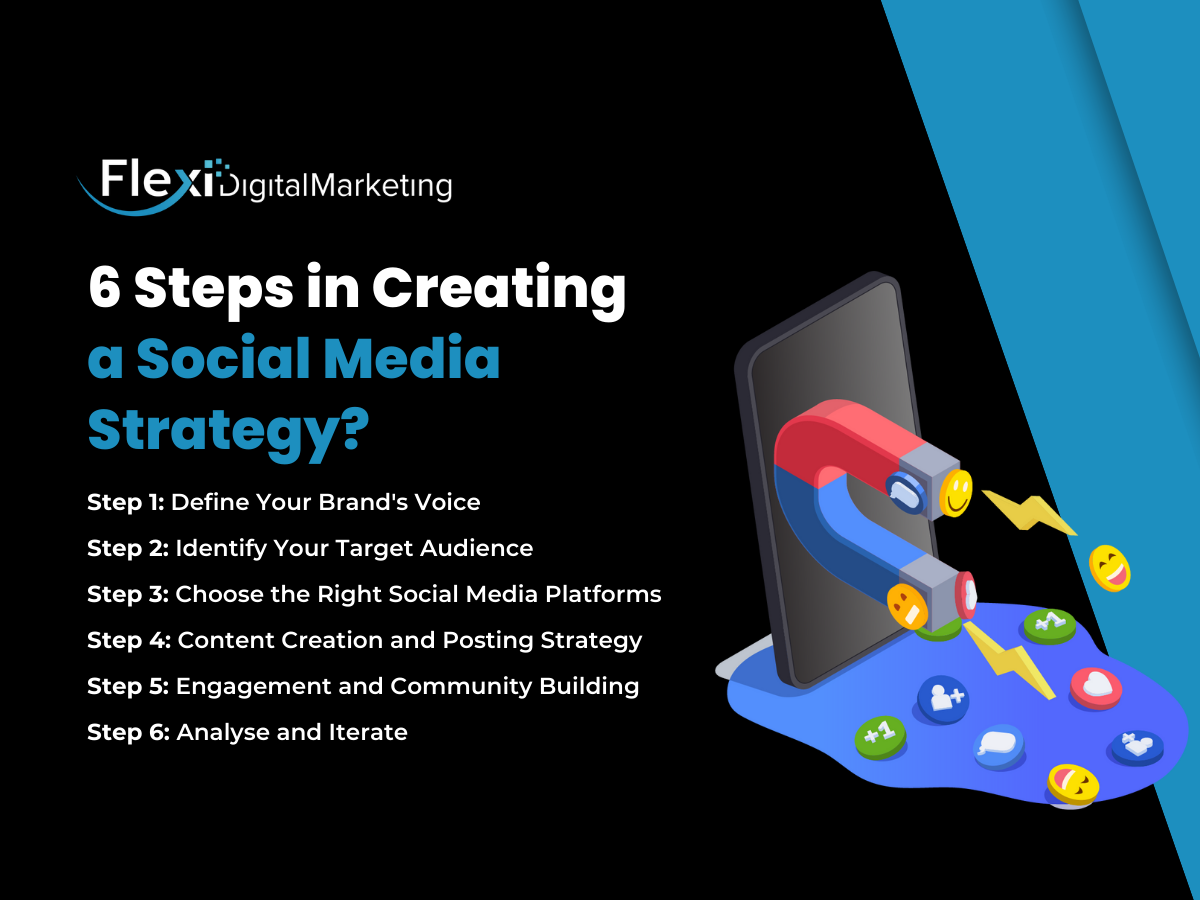In the digital age, a robust online presence is pivotal for the success of individuals, businesses, and organisations. With its vast user base and reach, social media is a cornerstone of this online presence.
However, success on social media doesn't happen by chance. It requires a well-defined strategy. In this comprehensive guide, we'll delve into social media strategy, exploring its definition, significance, and the six crucial steps in creating an effective method for building your brand on top social media platforms.
What is a social media strategy?
A social media strategy is a comprehensive plan that outlines how an individual, organisation, or business intends to use social media platforms to achieve specific goals and objectives. It involves a series of decisions and actions that help guide the use of social media deliberately and effectively.
A social media strategy encompasses various elements, such as identifying the target audience, creating compelling content that resonates with them, and engaging with followers to build meaningful relationships. It involves careful planning and execution to ensure the right message reaches the right people at the right time.
Here are some critical components of a social media strategy.
- Target Audience. One of the critical aspects of a successful social media strategy is understanding the target audience and their preferences. Businesses can gain valuable insights into their customers' behaviours and interests by conducting thorough research and analysis. This knowledge allows them to tailor content accordingly and deliver relevant and engaging messages.
- Content creation. This plays a crucial role in any social media strategy. It involves crafting compelling posts, videos, images, or other forms of content that capture attention and drive engagement. The goal is to provide value to followers while aligning with the brand's objectives.
- Engagement. It is another vital component of a social media strategy. It involves actively interacting with followers through comments, likes, shares, or direct messages. Businesses can foster stronger connections with their audience by responding promptly and authentically to user interactions.
- Analytics. This also plays a significant role in shaping an effective social media strategy. By monitoring key metrics such as reach, engagement rates, or conversions, businesses can measure the success of their efforts and make data-driven decisions for future campaigns.
What is the significance of a well-defined social media strategy?
A well-defined social media strategy can be a powerful tool for achieving your business or personal objectives, whether that involves building a brand, increasing engagement, or driving revenue. It provides a roadmap for consistent and purposeful online interactions across various social media platforms.
Specifically, it can help an organisation for the following reasons:
- Audience Engagement. It allows you to understand your target audience better, creating content and engagement strategies that resonate with their interests and needs. This leads to more meaningful and valuable interactions.
- Content Relevance. It guides the creation of content that aligns with your brand, message, and goals. Relevant content is more likely to engage and resonate with your audience.
- Adaptation and Improvement. With a strategy, you can track and measure the success of your social media efforts through key performance indicators (KPIs). This data-driven approach allows for ongoing optimisation and adjustment of your tactics for better results.
- Competitive Edge. A well-thought-out strategy often involves analysing your competitors' social media activities. This competitive analysis can help you identify opportunities, stay ahead in your industry, and differentiate your brand.
- Customer Insights. Social media strategies can provide valuable insights into your audience's preferences, behaviour, and feedback. This information can inform product development, marketing strategies, and other business decisions.
- Brand Social media is a powerful tool for building and reinforcing your brand's identity. A well-defined strategy ensures that your online presence aligns with your brand's values and messaging.
- Data-Driven Decision Making. Data and analytics are integral to a social media strategy. They help you make informed decisions and adjustments based on what works and what doesn't.
- Legal and Ethical Compliance. It helps ensure that your social media activities adhere to legal and ethical guidelines, minimising the risk of legal issues or reputational damage.
6 Steps in Creating a Social Media Strategy
Now that we understand the importance of a social media strategy let's delve into the six essential steps for creating one. These steps will guide you to build a solid brand presence on top social media platforms.

Step 1: Define Your Brand's Voice
Before you embark on your social media journey, it's essential to establish a consistent tone and messaging for your brand. Your brand's voice should reflect your values, personality, and the message you want to convey to your audience.
Here's how you can create your brand's voice:
- Know Your Brand Values. Start by identifying the core values that your brand represents. Are you all about innovation, authenticity, sustainability, or something else? Your brand's values should align with your mission and resonate with your target audience.
- Determine Your Brand's Personality. Think of your brand as a person. Is it friendly, professional, witty, or profound? Your brand's personality should be consistent with your values and appealing to your target audience.
- Develop Key Messaging. Craft key messages that convey your brand's mission and value proposition. These messages should be clear, concise, and memorable.
- Train Your Team. Ensure that everyone responsible for managing your brand's social media accounts understands and embodies the brand's voice. Consistency is critical to building brand identity and trust in your social media strategy.
Step 2: Identify Your Target Audience
You must know your audience inside and out to create an effective social media strategy. Buyer personas help you humanise your audience, making it easier to connect with them. This knowledge will guide your content creation and engagement strategies. Likewise, buyer personas are semi-fictional representations of your ideal customers,
Here’s how you can identify your target audience:
- Identify the age, gender, location, education, and other demographic details of your target audience.
- Psychographics. Dive into the psychological aspects of your audience. What are their interests, values, and pain points? What motivates them?
- Behaviour. Analyse their online behaviour. Where do they spend their time on social media? What types of content do they engage with?
- Challenges and Goals. Understand the challenges your audience faces and the goals they are trying to achieve. Your content should offer solutions and guidance.
- Pain Points and Objections. Anticipate objections and pain points your audience might have about your products or services. Address these in your content.
Step 3: Choose the Right Social Media Platforms
Not all social media platforms are created equal and don't serve the same purpose. Each social media platform has its unique audience, features, and communication style. As such, selecting the right platforms ensures you're not wasting resources on channels that don't align with your brand and audience.
You must choose the right platforms for your brand to succeed in your social media strategy. Here's how to do it:
- Platform Assessment. Evaluate the significant social media platforms to understand their demographics, user behaviour, and content types. Consider platforms like Facebook, Twitter, Instagram, LinkedIn, and TikTok.
- Audience Alignment. Match your target audience's demographics and behaviour with each platform's characteristics. Focus your efforts on the media where your audience is most active.
- Content Suitability. Consider the types of content that perform well on each platform. For example, Instagram is image-centric, while LinkedIn focuses on professional content.
- Competitor Analysis. Research where your competitors are most active and successful on social media. This can provide insights into which platforms are relevant to your industry.
- Resource Availability. Take into account the resources you have available, including time, budget, and creative capabilities. Choose platforms that you can consistently manage.
Step 4: Content Creation and Posting Strategy
Now that you know your brand's voice, target audience, and the platforms you'll be using, it's time to focus on creating engaging content. Effective content creation and posting strategies are crucial to attracting and retaining an engaged audience. Your content should be informative, entertaining, and valuable to your audience.
Here's how to craft a compelling content strategy:
- Content Planning. Outline the type of content you'll create, including text posts, images, videos, infographics, articles, and more. Align your content with your brand's messaging and your audience's interests.
- Content Calendar. Create a posting schedule to deliver consistent and timely content. Consider the best times to post, frequency, and use of content themes or campaigns.
- Visual Pay attention to the visual aspects of your content. High-quality images, graphics, and a cohesive visual style can enhance your brand's appeal.
- Content Decide how you'll promote your content. This might involve using relevant hashtags, collaborating with influencers, or running paid advertising campaigns.
- Engage your audience by telling compelling stories that resonate with your brand's narrative and values.
- Keyword and SEO Optimisation. For blog posts and articles, optimise your content for search engines to increase its visibility.
- User-Generated Content (UGC). Encourage your audience to create and share content about your brand, products, or services. UGC can be a powerful trust-building tool.
Step 5: Engagement and Community Building
Social media is not just a broadcasting tool; it's a two-way communication channel. Engagement and community building foster trust, loyalty, and brand advocacy among your audience. Building meaningful relationships with your audience is critical to a social media strategy.
Here's how to engage with your audience effectively:
- Respond Promptly. Be responsive to comments, messages, and mentions. Acknowledge your audience's feedback and questions promptly.
- Engage in Conversations. Initiate and participate in discussions related to your industry, products, or services. Encourage dialogue and provide valuable insights.
- Community Management. Create a sense of community around your brand. Encourage user-generated content and discussions among your audience.
- Personalise your interactions with your audience. Use their names and reference their specific needs or interests in your responses.
- Offer Value. Share helpful information, tips, and resources that benefit your audience. This positions your brand as a valuable source of information.
- Positive Brand Voice. Maintain a positive and supportive brand voice, even in challenging situations. Address criticism constructively.
- Surveys and Feedback. Seek feedback from your audience to understand their preferences and make improvements accordingly.
Step 6: Analyse and Iterate
No social media strategy is set in stone. To ensure its ongoing success, you must regularly analyse your performance, gather insights, and make data-driven improvements. Analysing and iterating your social media strategy ensures that you stay current, adapt to changes in your audience's behaviour, and effectively achieve your goals.
Here's how to do it:
- Key Performance Indicators (KPIs). Identify the KPIs that are relevant to your goals. Common KPIs include likes, shares, comments, click-through rates, conversion rates, and follower growth.
- Analytics Tools. Use social media analytics tools (provided by platforms like Facebook Insights, Twitter Analytics, and third-party tools) to track your performance.
- A/B Experiment with different content types, posting times, and engagement strategies. Compare the results to determine what works best for your brand and audience.
- Regular Reporting. Set a schedule for reviewing and reporting on your social media performance. Use these reports to identify trends and insights.
- Adjustment and Optimisation. Adjust your content strategy, posting schedule, and engagement tactics based on your analysis. Continuously refine your approach to improve your results.
- Benchmarking. Compare your performance to industry benchmarks and competitors. This can provide valuable context for your data.
Conclusion
In conclusion, crafting a successful social media strategy is crucial for building your brand on top platforms. A well-executed social media strategy can be a game-changer for your brand. Remember that the key to success lies in understanding your audience, creating valuable content, and actively engaging with your followers. With these principles, you can confidently navigate the social media landscape and build your brand on top platforms.
Ready to build your brand on social media with a winning strategy? Hire the best social media manager at Flexi Digital Marketing and take your online presence to the next level!


